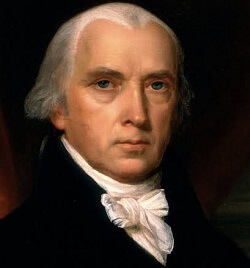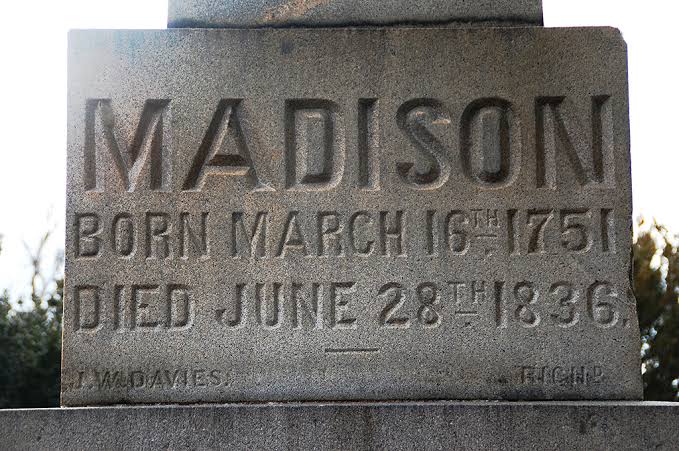James Madison
James Madison Jr. (March 16, 1751 - June 28, 1836) was a Founding Father, American statesman, and diplomat. From 1809 to 1817, he was the fourth President of the United States. Madison is known as the "Father of the Constitution" for his key role in creating and promoting the United States Constitution and the Bill of Rights. Madison was born into a prominent Virginia plantation family. During and after the American Revolutionary War, he was a member of the Virginia House of Delegates and the Continental Congress. Dissatisfied with the Articles of Confederation's insufficient national government, he helped organize the Constitutional Convention, which produced a new constitution. Madison's Virginia Plan served as the foundation for the Convention's discussions, and he was a powerful voice during the meeting. He became a leader in the ratification effort. He collaborated with Alexander Hamilton and John Jay on The Federalist Papers, a collection of pro-ratification essays that is now considered a classic work of political science in American history. Madison rose to prominence in the House of Representatives and served as a close adviser to President George Washington. During the early 1790s, Madison rejected Secretary of the Treasury Hamilton's economic policy and the attendant concentration of power, and he founded the Democratic-Republican Party to counter Hamilton's Federalist Party. Madison served as Thomas Jefferson's Secretary of State from 1801 to 1809 after he was elected president in 1800. In that capacity, he oversaw the Louisiana Purchase, which effectively increased the size of the United States. Madison was elected President in 1808. After diplomatic complaints and a trade embargo failed to stop British seizures of American vessels, he led the United States into the War of 1812. The war was an administrative disaster that failed, but many Americans saw it as a triumphant "second battle of independence" against Britain. Madison was re-elected in 1812, albeit by a narrower margin than in 1808. The conflict convinced Madison of the need for a larger federal government. He presided over the establishment of the Second Bank of the United States and the passage of the Protective Tariff of 1816. PresidencyMadison took the oath of office and was inaugurated as president on March 4, 1809. In contrast to Jefferson, who had near unanimity of support, Madison encountered political resistance from Monroe and Clinton. Furthermore, the Federalist Party was resurrected as a result of the embargo. Aside from his anticipated nomination of Gallatin for secretary of state, the remaining members of Madison's Cabinet were picked primarily to promote political concord and were mainly unremarkable or incompetent, according to historians Ketcham and Rutland. Madison encountered early opposition to his intended appointment of Treasury Secretary Gallatin as Secretary of State. Madison ultimately decided against nominating Gallatin, retaining him in the Treasury Department. Instead, Madison appointed Robert Smith, the brother of Maryland Senator Samuel Smith, as secretary of state. However, due to Smith's inefficiency, Madison filled most of the secretary of state's duties over the next two years. Madison finally replaced Smith with Monroe in April 1811, after severe intra-party rivalry. Madison rarely convened Cabinet sessions, preferring to speak with Gallatin alone, despite having a Cabinet full of people he disliked. Early in his presidency, Madison intended to carry on Jefferson's principles of low taxes and debt reduction. After Madison declined to take a firm stand on the issue, Congress allowed the charter of the First Bank of the United States to lapse in 1811. In the 1816 presidential election, Madison and Jefferson both supported Secretary of State James Monroe's candidacy, which was rejected in the party's congressional nominating caucus by Secretary of War William H. Crawford. Monroe easily defeated Federalist candidate Rufus King in the 1816 election as the Federalist Party began to crumble. Madison departed office as a popular president; former President Adams stated that Madison "earned more glory, and established more union, than all his three predecessors, Washington, Adams, and Jefferson combined." Madison retired to Montpelier, near Jefferson's Monticello, after leaving office in 1817 at the age of 65. Madison, like Washington and Jefferson, left the presidency a poorer man than when he arrived. Due to tobacco price decreases and his stepson's mismanagement, his plantation underwent a continuous financial collapse. In his retirement, Madison became involved in public affairs on occasion, advising Andrew Jackson and other presidents. He stayed out of the public fight over the Missouri Compromise, though he privately lamented the North's hostility to slavery's spread. Madison had friendly contacts with all four major presidential contenders in the 1824 election, but, like Jefferson, he generally stayed out of the race. During Jackson's administration, Madison officially condemned the Nullification movement, claiming that no state had the authority to secede. Madison also assisted Jefferson in the establishment of the University of Virginia. Madison was chosen as the university's second rector in 1826, following Jefferson's death. He served as college chancellor for eleven years until his death in 1836. Madison was elected as a representative to the Virginia Constitutional Convention in 1829, at the age of 78, to revise the commonwealth's constitution. It was his final public appearance as a statesman. The key issue in the convention for Virginia's western districts was the allocation of proper representation. Personal LifeMadison was the country's most short president, at only 5 ft 4 in (1.63 m) tall and weighing no more than 100 lb (45 kg). He had brilliant blue eyes and was known for being amusing in small groups. Madison was frequently sidelined following periods of stress due to instances of mental tiredness and illness, as well as related anxiousness. He was a hypochondriac who often dreaded the worse. Madison, on the other hand, was physically capable and in generally good physical health until his very last years. Madison married Dolley Payne Todd, the 26-year-old widow of John Todd, a Quaker farmer who died during a yellow fever epidemic in Philadelphia, on September 15, 1794. After staying in the same boardinghouse as Burr in Philadelphia, Aaron Burr introduced Madison to her at his request. Following an arranged meeting in early 1794, the two got romantically engaged and planned to marry that summer, but Dolley suffered from chronic illnesses as a result of her exposure to yellow fever in Philadelphia. They eventually proceeded to Virginia for their wedding at Harewood. Only a few close family members were present, and the ceremony was presided over by Winchester Reverend Alexander Balmain. Madison, an introspective man, had a close relationship with his wife and relied heavily on her to deal with the social constraints of being a famous figure. She rose to prominence in Washington, D.C., and excelled at hosting dinners and other key political events. Dolley Madison contributed to the contemporary image of the first lady of the United States as a figure who plays a leadership role in the nation's social affairs. Madison never had children, but after the marriage, he adopted Dolley's surviving son, John Payne Todd (known as Payne). Some of Madison's colleagues, such as Monroe and Burr, claimed that he was infertile and that his lack of offspring weighed heavily on his mind; nevertheless, Madison never expressed any such grief. Nonetheless, his fertility has been called into question in recent years following a widely circulated 2007 Washington Post article in which an African-American named Bettye Kearse claimed to be a descendant of Madison and an enslaved person named Coreen. Madison had a close relationship with his father, James Sr., until his death in 1801. Madison inherited the huge farm of Montpelier and other holdings, including his father's numerous slaves, when he was 50 years old. Ambrose, the youngest of his six siblings to reach adulthood, assisted his father and older brother in running Montpelier until his death in 1793. LegacyMadison, one of the United States' Founding Fathers, had a significant impact on the nation's founding as well as the early development of American constitutional governance and foreign policy. According to historian J. C. A. Stagg, "Madison was the most successful and possibly the most influential of all the Founding Fathers in certain ways-because he was on the winning side of every critical issue confronting the nascent nation from 1776 to 1816." Despite the fact that he helped form a significant political party and served as the fourth president, his reputation has been defined largely by his contributions to the Constitution; even during his lifetime, he was referred to as the "Father of the Constitution." Madison "developed and conceptualised the current ideal of an extended, federal constitution that combines local self-government with an overarching national order," notes law professor Noah Feldman. Madison's "concept of liberty-protecting constitutional government," according to Feldman, is "the most significant American notion in global political history." Many historians have slammed Madison's presidency. The prevalent perception of Madison, according to Henry Steele Commager and Richard B. Morris in 1968, was of a "incapable President" who "mismanaged an unnecessary war." Madison's failure to avoid the War of 1812 was regarded as the sixth-worst error made by a sitting president in a 2006 poll of historians. Regarding Madison's consistency and adaptability of policymaking during his many years of political activity, historian Gordon S. Wood claims that Lance Banning is the "only modern-day scholar to maintain that Madison did not change his views in the 1790s," as stated in his Sacred Fire of Liberty (1995). During and after the War of 1812, Madison favored several policies he had opposed in the 1790s, such as a national bank, a powerful navy, and direct taxes. Many historians struggle to comprehend Madison, but Wood sees him through Madison's eyes-as a nationalist, but one with a different definition of nationalism than the Federalists. Other ways are used by Gary Rosen to suggest Madison's consistency. The Madison family's plantation, Montpelier, has been named a National Historic Landmark. The James Madison Memorial Building is a branch of the United States Library of Congress that serves as Madison's official memorial. As part of the Constitution's bicentennial celebrations, Congress established the James Madison Memorial Fellowship Foundation in 1986. Madison, Wisconsin, and Madison County, Alabama, are two other places named after Madison, as are Madison Square Garden, James Madison University, and the USS James Madison. Death
Madison's health worsened gradually throughout the early to mid-1830s. The Fourth of July happened to be the day that former presidents Jefferson, Adams, and Monroe all died. Madison's doctors urged him to take stimulants in his final week in order to extend his life until July 4, 1836. Madison, though, refused. He died of congestive heart disease on June 28, 1836, at the age of 85, in Montpelier. According to one popular tale of his final moments, he was offered breakfast, which he tried to eat but couldn't swallow. "What's the matter, Uncle James?" questioned his favourite niece, who sat by to keep him company. Madison died moments after responding, "Nothing more than a change of heart, my dear." He was laid to rest in the family cemetery in Montpelier. He was one of the last significant Revolutionary War generation members to die. His will bequeathed large sums to the American Colonization Society, Princeton, and the University of Virginia, as well as $30,000 ($897,000 in 2021) to his wife, Dolley. Dolley struggled financially until she died in 1849, having been left with little money than Madison had expected. To pay off outstanding debts, Dolley sold Montpelier, its surviving slaves, and the furniture in the 1840s.
Next TopicJasmine Davis
|
 For Videos Join Our Youtube Channel: Join Now
For Videos Join Our Youtube Channel: Join Now
Feedback
- Send your Feedback to [email protected]
Help Others, Please Share









